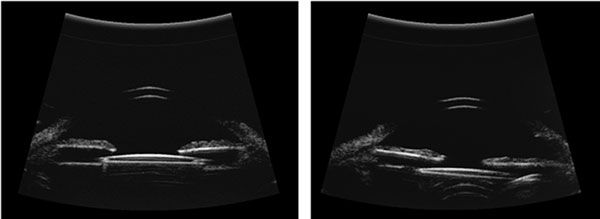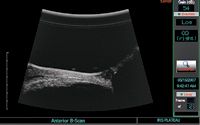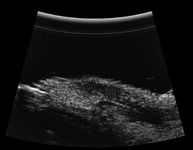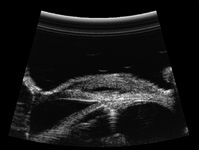Article
A new view on imaging the anterior segment
A new version of an ophthalmic ultrasound system has the unique ability to image all aspects of the anterior segment. As a key differentiator to optical coherence tomography, the ultrasound system, which has a high-frequency B-probe, enables the user to see behind the iris and create dynamic movies rather than static images.

Key Points

Although the ophthalmic ultrasound system (Eye Cubed, Ellex) has been around for years, and it represents the gold standard in ultrasound imaging for the retina, we have recently incorporated the third version of this system, with its high-frequency B-probe, into our practice.
Previously, ultrasound primarily meant A-scan biometry for us. With the addition of the newer system, we've started to change the way we use the technology because of its unique ability to image all aspects of the anterior segment. As a key differentiator to optical coherence tomography, the ophthalmic ultrasound system enables us to see behind the iris and create dynamic movies rather than static images.
The system also offers a 30° image field with a depth of up to 12 mm, which means that we can see the entire lens apparatus, as well as the zonules and ciliary muscles-areas that we really haven't been able to visualize previously. According to the manufacturer, this is due to a high signal-to-noise ratio, which reduces noise to a minimum, thereby improving the quality of the resolution.
In addition, the system captures up to 10-second movies during the exam, with a sampling rate of 13 frames per second, the highest available today. That rate enables us to view movement in the anterior segment in real time, something that was not possible before.
In the time since we've added the ophthalmic ultrasound system, I've been putting the system to the test to see how we can benefit from its imaging capabilities. What I've found is that it is particularly useful in cases in which patients are experiencing issues with their IOLs, particularly premium IOLs, as well as in my patients with glaucoma.
Following are several case studies illustrating how the ophthalmic ultrasound system has helped improve our understanding and diagnostic ability.
IOL case studies
Case 1-A 57-year-old, who had undergone bilateral implantation of an apodized diffractive lens (AcrySof ReSTOR, Alcon Laboratories) just a few days earlier, arrived in our office presenting blurred vision in the right eye. Refraction showed a myopic error of –2 D in that eye.

What went wrong? On the way home from the 1 day postoperative visit, this patient was involved in a car accident and suffered a significant jolt-one that was strong enough to vault the IOL out of the bag and into the sulcus.
Case 2-This patient came to see us complaining of dysphotopsia that she described as arcs of light. She already had been to several surgeons, asking that her IOL be removed, although refraction was 20/15. To treat the problem, we placed a plano, foldable IOL (Elastimide, STAAR Surgical) in the ciliary sulcus and in front of the IOL in the capsular bag.
Case 3-How exactly accommodation works remains uncertain. Use of the ophthalmic ultrasound system can help us understand better what is happening during the accommodative process, both with natural lenses as well as in eyes that have phakic lenses. In the imaging work that we've done with the wide-field probe, we've been able to spot subtleties that we had never seen before.
An excellent example of this situation is a 64-year-old man who had received two accommodating IOLs (crystalens, Bausch & Lomb Surgical). He had great near vision in one eye, with a poorer result in his fellow eye. As it turned out, he had received two different models of the accommodative lens. In one eye, he had received a square-edge design IOL (AT45SE, Bausch & Lomb) in June 2006; in the second eye, he had received a new model with a different haptics design in March 2007.
When we imaged the eye with the older IOL model, it was possible to see the space between the anterior surface. The iris had shortened by about 1 to 1.5 mm during accommodation (Figure 3). A slight shift also occurred in the haptics of the IOL.
The imaging of the second eye, with the newer model implanted, showed more of an anterior vaulting during accommodation. This result supported what the patient was experiencing: better vision with the second eye. We elected to leave the IOL in the bag and live with some monovision because the IOLs seemed to be positioned correctly.
Imaging in glaucoma cases
In patients with glaucoma, the wide-field B-scan imaging really can be of use in trying to determine what is happening with the angle, such as iris plateau syndrome and similar problems.
Case 2-In this eye, the imaging showed a much different picture because the patient with glaucoma had narrow angles (Figure 5). With the wide-field ultrasound imaging, we were able to measure the anterior chamber depth and the papillary distance. We paused the image and used calipers to get the measurement.

Case 3-Another area where wide-field high-resolution imaging is helpful in glaucoma is in eyes with a valve or tube implanted that is not functioning properly.
In case 3, the patient had a glaucoma implant (Baerveldt, Advanced Medical Optics) placed superiorly, with a glaucoma valve (Ahmed, New World Medical) placed inferiorly. When the IOP did not drop as we had expected after the valve was implanted, we used the ophthalmic ultrasound system to investigate.


Our experience has found that the wide-field B-scan on the ophthalmic ultrasound system quickly has become one of the best diagnostic tools we have for helping to sort out anterior segment issues. The ability to have a live, dynamic image really helps to provide a clear picture of what is going on in the eye, which can help to determine better treatment options.
E. Randy Craven, MD, is in practice in the Denver area with the Glaucoma and Cataract Consultants of Colorado. He is an associate clinical professor of ophthalmology at the University of Colorado School of Medicine. He also served on the board of directors and as chairman of the risk management committee for the Ophthalmic Mutual Insurance Co. He was part of the group that received The Lewis Rudin Glaucoma Prize of the New York Academy of Medicine. His interests within glaucoma include scanning laser technologies, surgical wound revisions, and management issues. Dr. Craven is a speaker for Ellex. Readers may contact Dr. Craven by phone at 303/797-1900 or by e-mail at ercraven@glaucdocs.com
.
Newsletter
Don’t miss out—get Ophthalmology Times updates on the latest clinical advancements and expert interviews, straight to your inbox.




